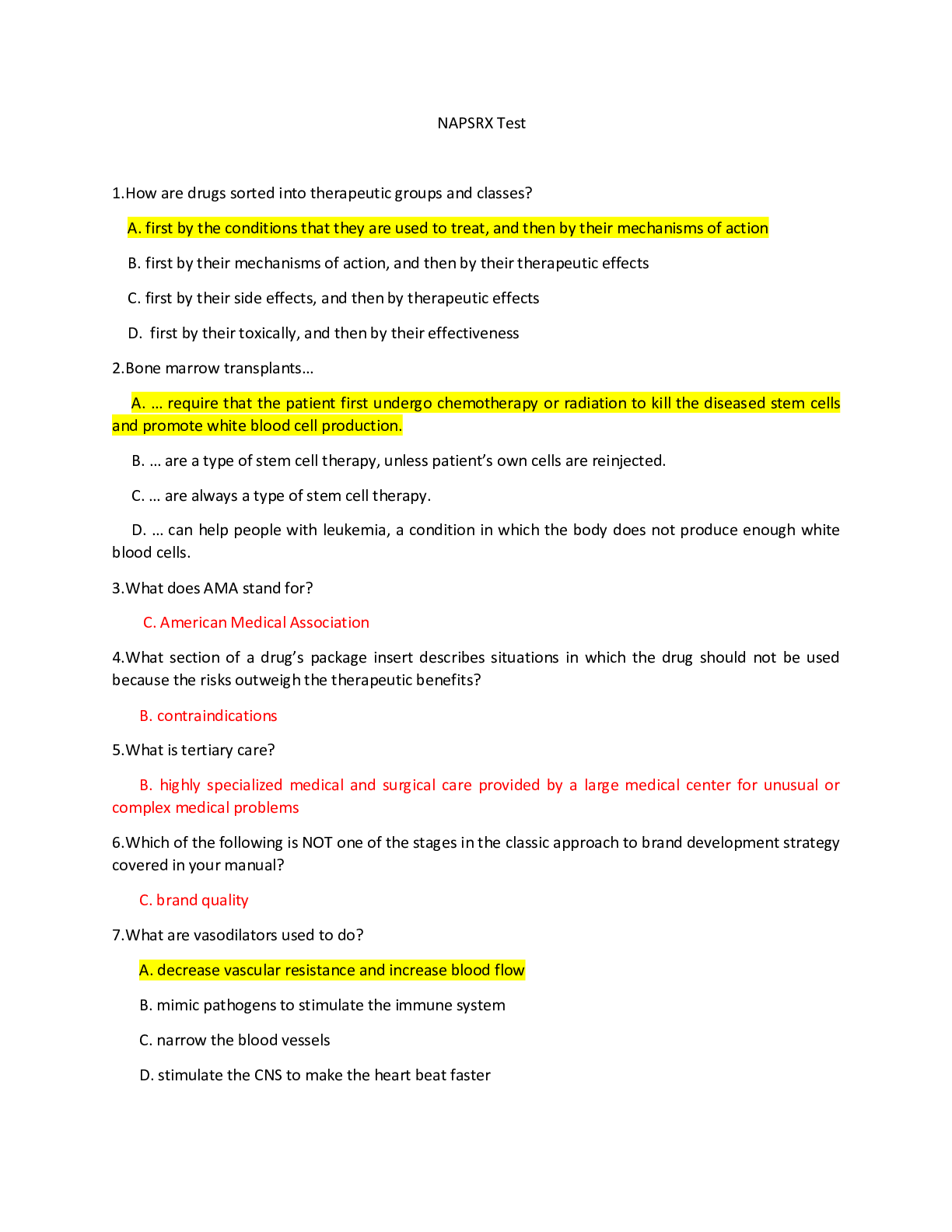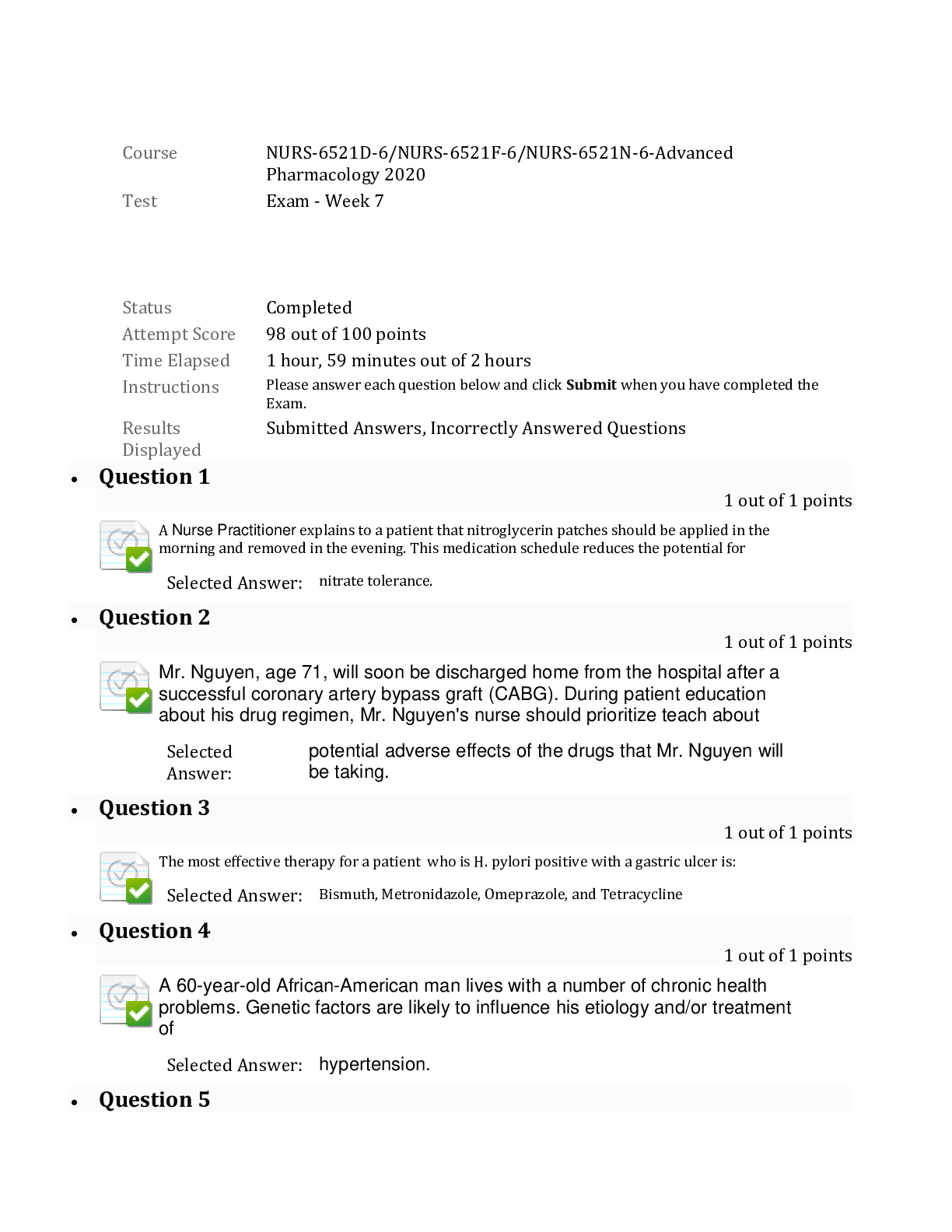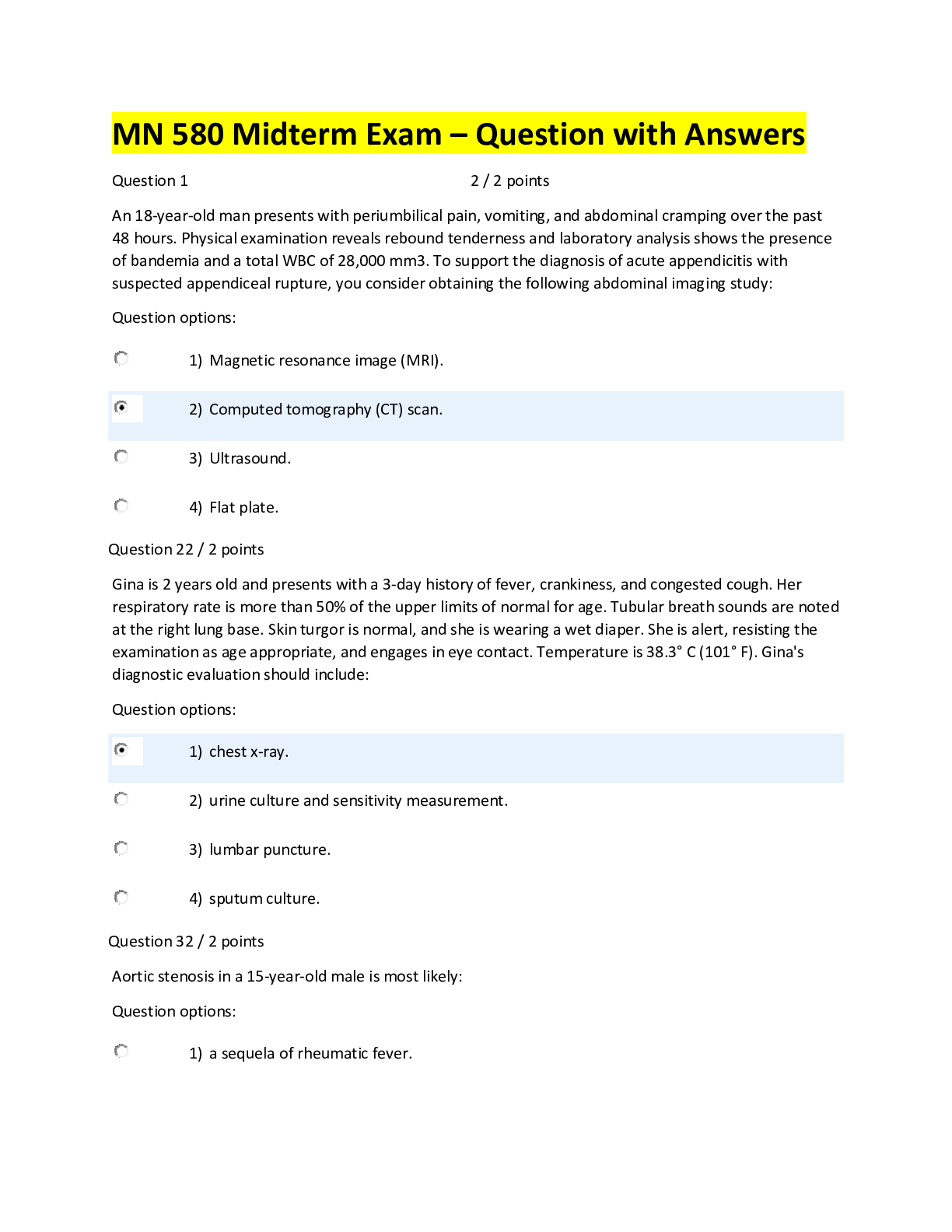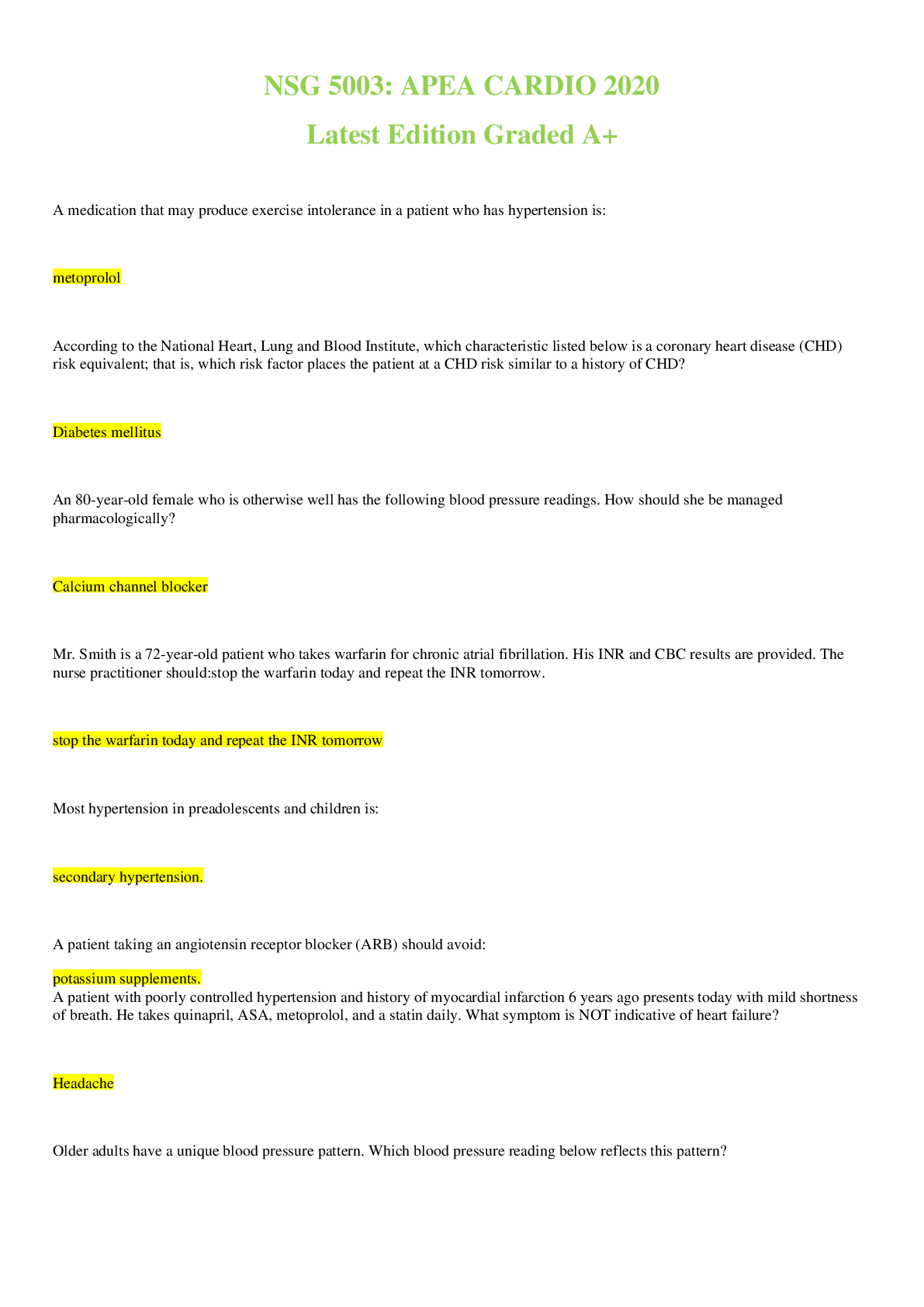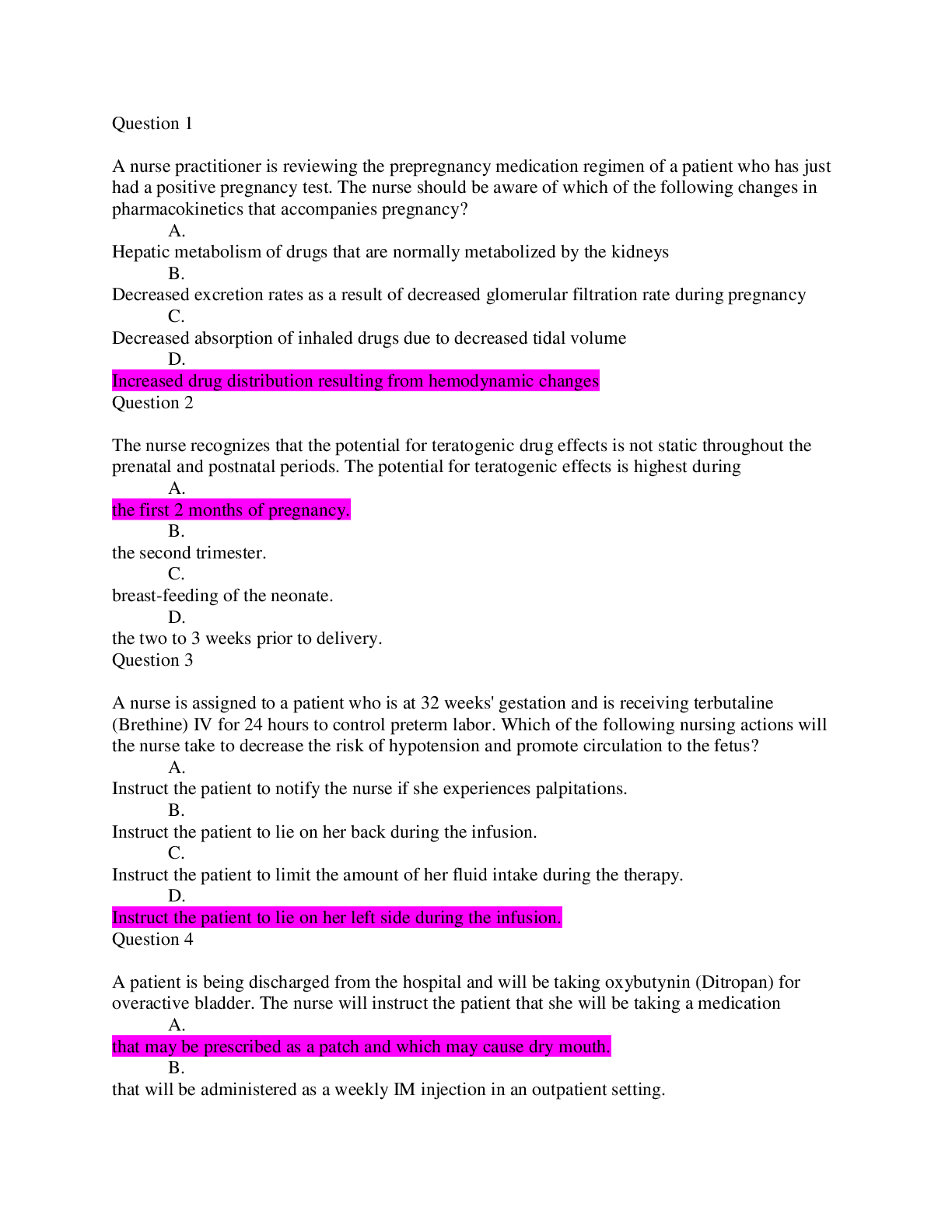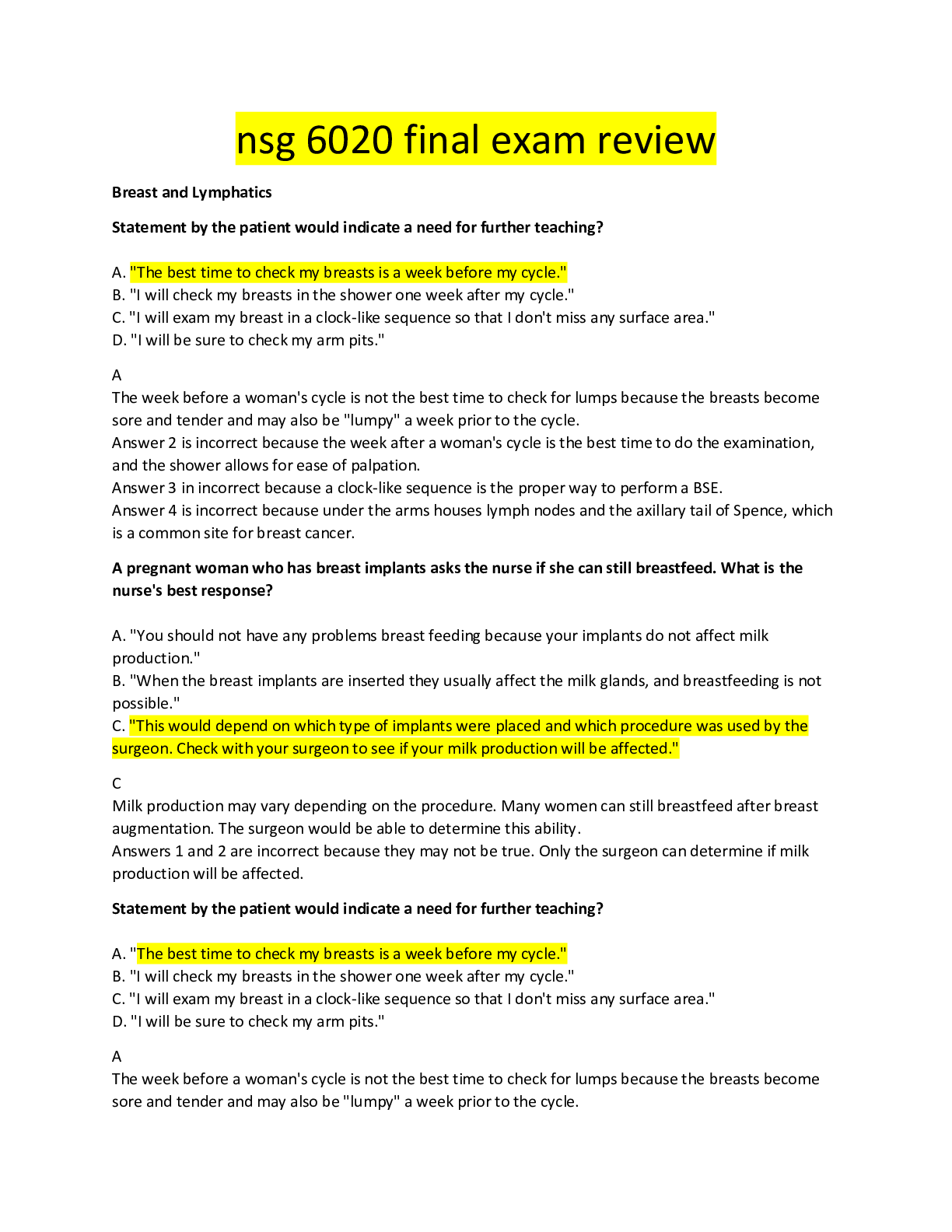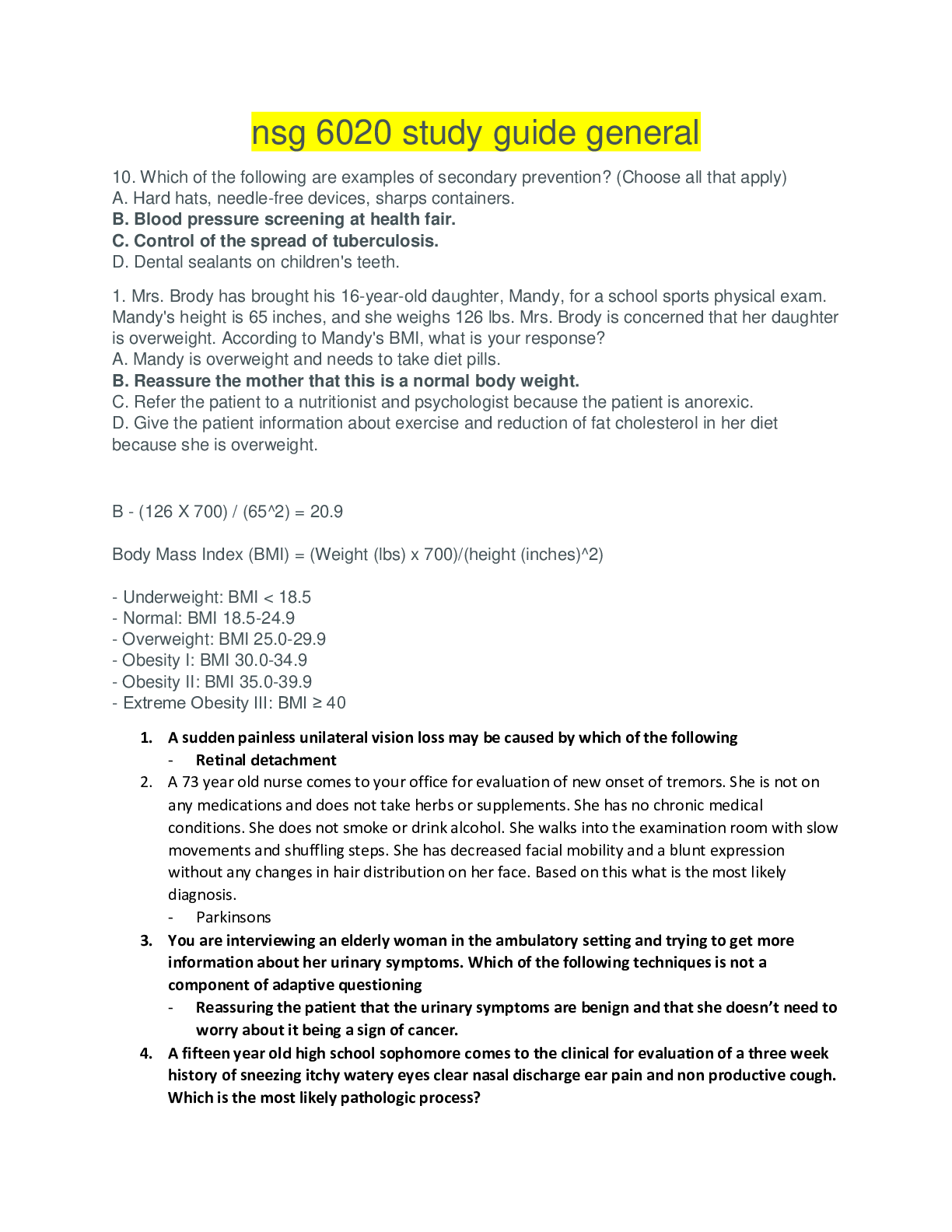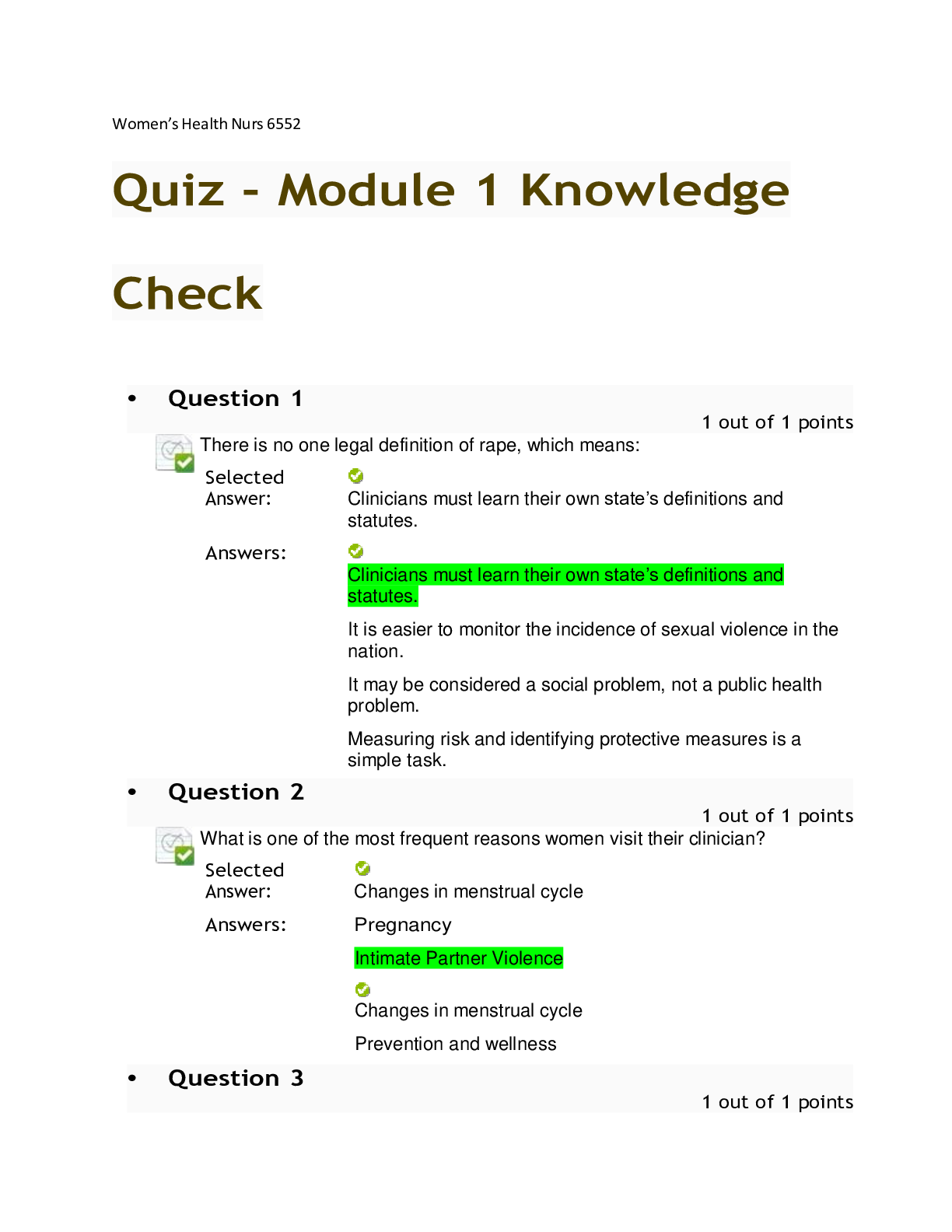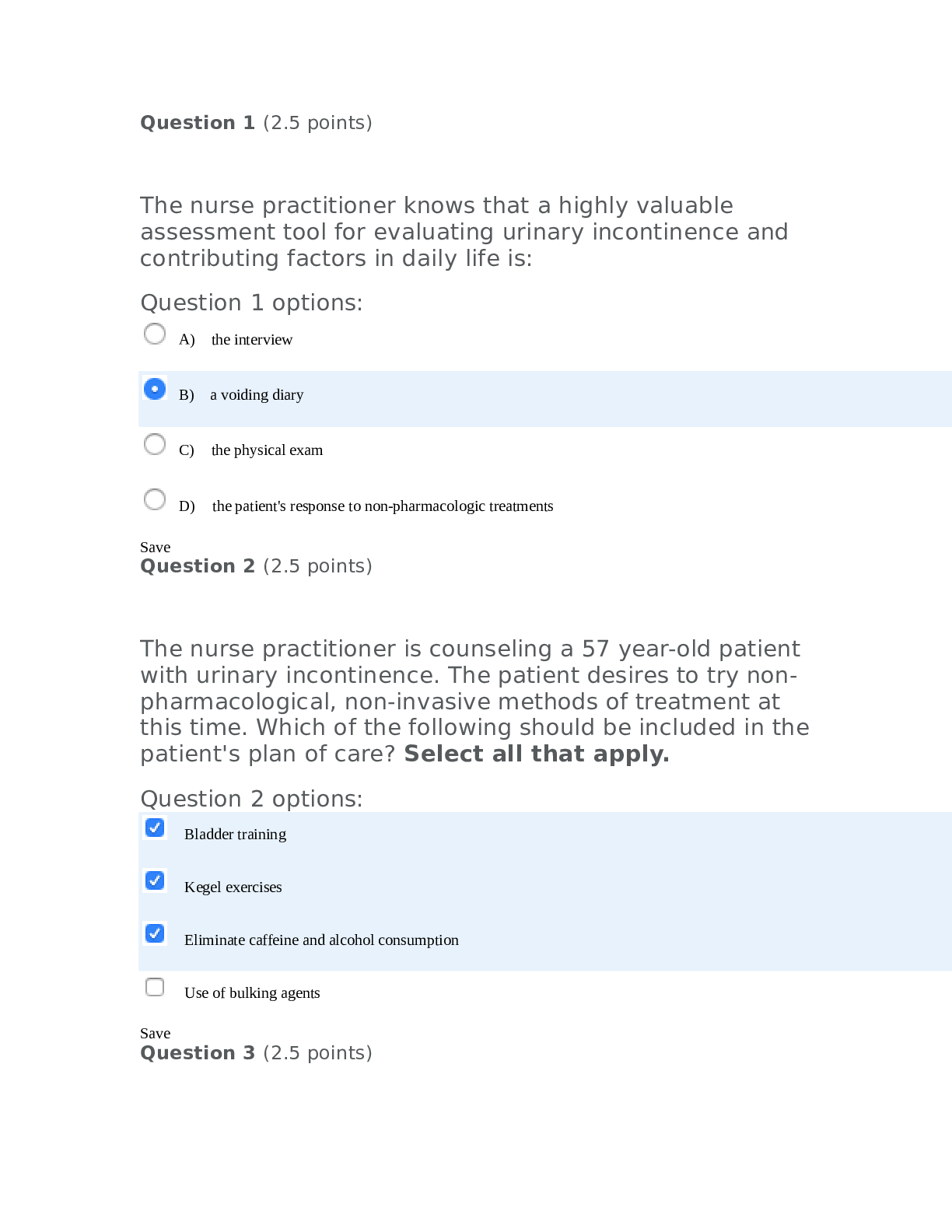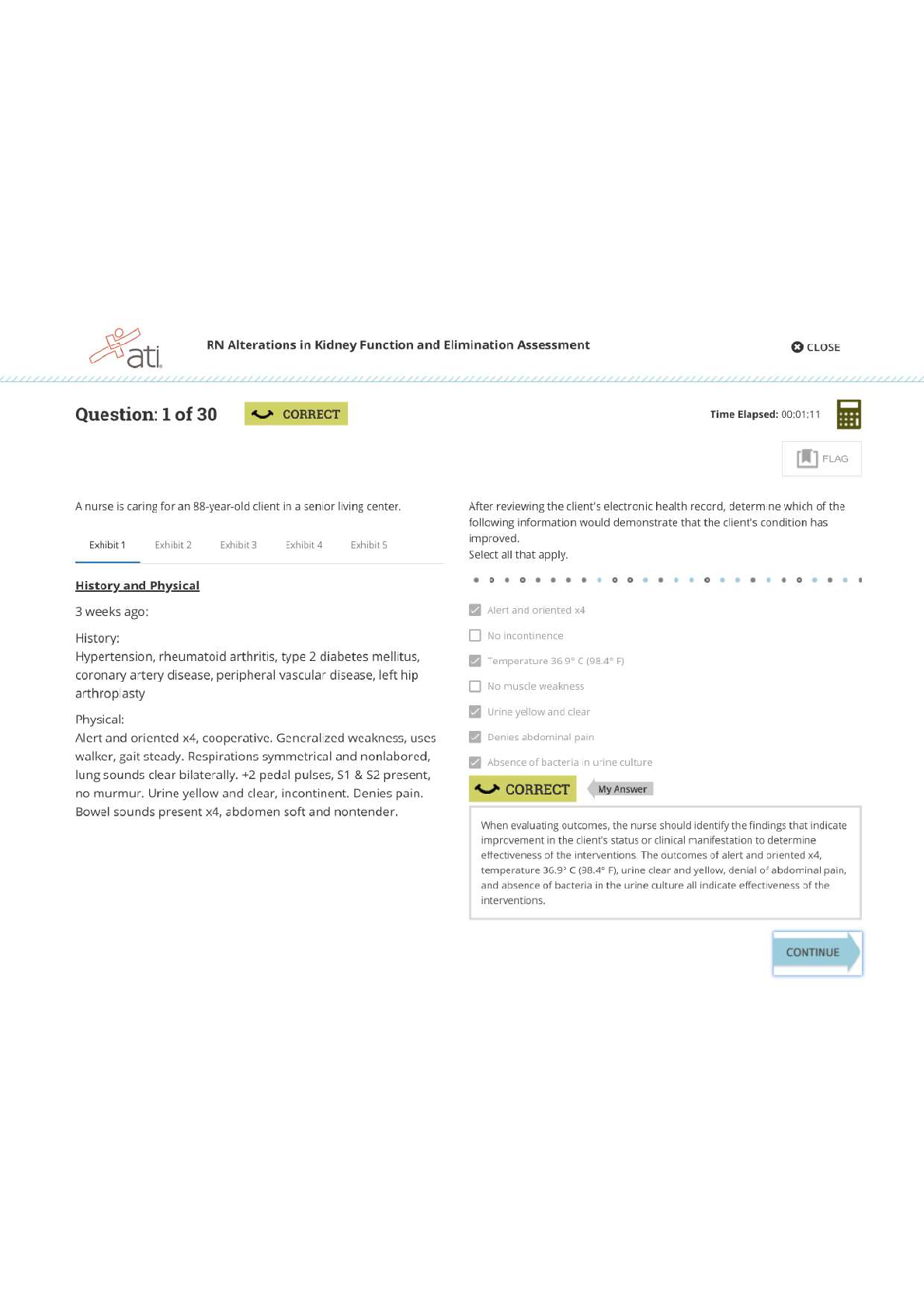*NURSING > EXAM > NSG 6430 Womens Health - South University Final Exam / NSG6430 Final Exam 2023. 100 Q&A (graded A) (All)
NSG 6430 Womens Health - South University Final Exam / NSG6430 Final Exam 2023. 100 Q&A (graded A)
Document Content and Description Below
NSG 6430 Womens Health - South University Final Exam / NSG6430 Final Exam Question 1 (2.5 points) The nurse practitioner knows that a highly valuable assessment tool for evaluating urinary incon... tinence and contributing factors in daily life is: Question 1 options: A) the interview B) a voiding diary C) the physical exam D) the patient's response to non-pharmacologic treatments Save Question 2 (2.5 points) The nurse practitioner is counseling a 57 year-old patient with urinary incontinence. The patient desires to try non-pharmacological, non-invasive methods of treatment at this time. Which of the following should be included in the patient's plan of care? Select all that apply. Question 2 options: Bladder training Kegel exercises Eliminate caffeine and alcohol consumption Use of bulking agents Save Question 3 (2.5 points) The nurse practitioner is performing a bimanual exam on a new OB patient and notices that the lower portion of the patient’s uterus is soft. This is known as: Question 3 options: A) Hegar's Sign B) Chadwick's Sign C) Nightingale's Sign D) Goodell's Sign Save Question 4 (2.5 points) Your female patient presents for vaginal discharge with an odor, and has noticed painless “bumps” on her vaginal area. Sexual history includes past male partners and her current female partner. On exam you note beefy red papules and an ulcerative lesion on her vulva, granular tissue and scarring, and inguinal adenopathy. You suspect she has: Question 4 options: A) HSV-2 B) Granuloma Inguinale C) Chancroid D) Molluscum Contagiosum Save Question 5 (2.5 points) The physical examination of any woman suspected of being abused or battered includes all of the following except: Question 5 options: A) a thorough inspection for signs of injury, past and present B) a physical assessment just like that of any other adult female C) a focus on the patient's physical appearance, not her behavior D) the use of body maps and diagrams to accurately portray the patient's physical condition Save Question 6 (2.5 points) The most effective means of obtaining the history of abuse is to use a communication model that: Question 6 options: A) avoids having the patient's children present during the discussion B) signals someone is interested and that the woman is not alone C) emphasizes the belief that violence is not acceptable, no matter what the batterer might have said to the patient D) allows the patient to talk without interruption and with time to relate, emphasize, and repeat her full story Save Question 7 (2.5 points) Clinicians should routinely consider intimate partment violence (IPV) as a possible diagnosis for women who present with all of the following except: Question 7 options: A) chronic stress-related symptoms B) denial of any physical health problems C) central nervous system (CNS) symptoms D) gynecologic problems, especially multiple ones Save Question 8 (2.5 points) The factors that enable women to enjoy and control their sexual and reproductive lives, including a physical and emotional state of well-being and the quality of sexual and other close relationships, make up a woman's: Question 8 options: A) sexual health B) gender identit C) gender role behaviors D) psychosocial orientation Save Question 9 (2.5 points) Which one of the following is not among the ways clinicians can provide a welcoming, safe environment for Lesbian, Gay, Bixsexual, or Transgender (LGBT) patients? Question 9 options: A) Avoid the heterosexual assumption by using gender-neutral language. B) Explain whether and how information will be documented in the patient's medical record. C) Ignore the sexual status or gender identity of all patients. D) Offer mainstream referrals that are culturally sensitive to SGMs. Save Question 10 (2.5 points) Which one of the following is the definition of the term "gender identity"? Question 10 options: A) People who respond erotically to both sexes B) A self-label, regardless of biologic or natal sex C) People who are similar in age, class, and sexual status D) A label for behavior not usually associated with one's natal sex Save Question 11 (2.5 points) Which one of the following statements about sexually transmitted infections (STIs) is false? Question 11 options: A) Lesbians are at very low risk for development of STIs and vaginal infections. B) HIV has been identified in case studies of women who report sex only with women. C) Transgender women (Male to Female) have extremely high rates of HIV infection. D) Risky behaviors for STIs include sex during menses. Save Question 12 (2.5 points) Among the midlife health issues of women, the number one cause of mortality in the United States is: Question 12 options: A) primary osteoporosis B) cardiovascular disease C) overweight and obesity D) cancer Save Question 13 (2.5 points) Lifestyle approaches to manage menopause related vasomotor symptoms include: Question 13 options: A) sleeping more than 8 hours per night B) avoiding spicy foods, hot drinks, caffeine, and alcohol C) decreasing levels of physical activity D) more than 1,000 international units/day of vitamin E Save Question 14 (2.5 points) The standard for managing moderate to severe menopausal symptoms is: Question 14 options: A) lifestyle changes, such as dieting and exercising B) nonhormone products, such as antidepressant medications C) alternative care, such as acupuncture, combined with organic herbs D) prescription systemic hormone products, such as estrogen and progestogen Save Question 15 (2.5 points) The nurse practitioner is managing an adolescent with a 4 cm functional ovarian cyst that was confirmed on a recent ultrasound. What plan of care should be anticipated for this patient? Question 15 options: A) Repeat bimanual exam in 1 week B) Refer for surgical consult C) Repeat ultrasound in 2 months D) Stop all ovulatory inhibitor meds Save Question 16 (2.5 points) Non-pharmacologic therapy for chronic pelvic pain includes the following: Select all that apply. Question 16 options: A) Vitamin B6 B) Physical therapy C) Aerobic and nonaerobic exercise D) Antidepressants Save Question 17 (2.5 points) The nurse practitioner understands that all of the following organisms are responsible for infection of the Bartholin's gland except: Question 17 options: Streptococcus faecalis Klebsiella Staphylococcus aureus E. Coli Save Question 18 (2.5 points) Treatment of a large, symptomatic Bartholin's cyst includes all of the following except: Question 18 options: Sitz baths Incision and drainage Topical corticosteroids Antibiotics Save Question 19 (2.5 points) A 44 year-old African American female presents with complaints of menorrhagia x 15 months. Pelvic ultrasound confirms the presence of a large intramural leiomyomata. The nurse practitioner should discuss all of the following options with the patient except: Question 19 options: GnRH agonist therapy Referral for surgical consult Progestin therapy Estrogen therapy Save Question 20 (2.5 points) The nurse practitioner is treating a patient with Elimite for scabies. The proper instructions to the patient should include: Question 20 options: All household contacts should be treated with Elimite regardless of symptoms. The medication should be taken orally in one single dose and repeated in 2 weeks. Apply only to the body area infested with scabies and repeat treatment in 5 days. Apply to all areas of the body from the neck down, wash off after 8 to 14 hours, then repeat treatment in one week Save Question 21 (2.5 points) The nurse practitioner understands that the proper management of an asymptomatic woman with a small fibroid should include: Question 21 options: Start combination COC therapy. Repeat ultrasound in 3-4 months. Reassess in 6 to 12 months. Refer for myomectomy. Save Question 22 (2.5 points) The nurse practitioner is teaching a patient about pediculosis. Which of the following statements by the nurse practitioner is correct? Question 22 options: Nits can survive in hot and humid climates up to 21 days.” “Adult pubic lice can survive 72 hours off their host.” “Pruritus is not a common manifestation.” “The condition is treated with Permethrin cream.” Save Question 23 (2.5 points) All of the following medications may be used for neuropathic pain management of vulvodynia, except: Question 23 options: Neurontin SSRIs Methotrexate Tricyclics Save Question 24 (2.5 points) The nurse practitioner understands that which of the following lab tests is appropriate for the patient who presents with symptoms of dysesthetic vulvodynia? Question 24 options: RPR Pap smear Wet mount Endometrial biopsy Save Question 25 (2.5 points) Which of the following is a common antibiotic for treatment of an infected Bartholin's cyst? Question 25 options: Minocycline Levaquin Bactrim Ampicillin Save Question 26 (2.5 points) The patient presents with complaints of a painful, swollen lump in her vaginal area. She reports difficulty sitting and walking due to the pain. Which of the following is a likely diagnosis for this patient? Question 26 options: Syphilis chancre Lichen Planus Genital Wart Bartholin's cyst Save Question 27 (2.5 points) The nurse practitioner understands that which of the following are differential diagnoses in an adult female patient with acute pelvic pain. Select all that apply: Question 27 options: A) Ectopic pregnancy B) Appendicitis C) Ovarian cyst with rupture D) Pelvic Congestion Syndrome Save Question 28 (2.5 points) When women experience mild premenstrual symptoms, such as mild breast tenderness, abdominal bloating, and mild weight gain from water retention, this is known as: Question 28 options: Luteal phase deficiency Premenstrual dysmorphic disorder Premenstrual syndrome Follicular phase deficiency Save Question 29 (2.5 points) A patient with intraductal papilloma will commonly present with a chief complaint of: Question 29 options: A palpable mass Bloody nipple discharge Bilateral milky discharge Mild localized pain Save Question 30 (2.5 points) The nurse practitioner understands that the necessary screening techniques in a patient suspicious of ovarian cancer should include the following: Select all that apply. Question 30 options: CA-125 Transvaginal ultrasound Bimanual pelvic exam Pap smear Save Question 31 (2.5 points) Early symptoms experienced by a woman with ovarian cancer include all of the following except: Question 31 options: Vague abdominal pain Abdominal bloating Fatigue Unexplained weight gain Save Question 32 (2.5 points) The nurse practitioner is evaluating a patient's risk of ovarian cancer. All of the following factors are associated with an increased risk for ovarian cancer except: Question 32 options: First degree relative with ovarian cancer BRCA -1 and 2 mutations Obesity Oral Contraceptive Use Save Question 33 (2.5 points) Patient education for condylomata acuminata should include all the following except: Question 33 options: The cause of the condition is a virus of the HPV type Sexual partners should be checked and condoms used to decrease incidence of transmission Treatment and elimination of visible warts is a sign of cure, and transmission will not occur The virus does not always cause a lesion, subclinical infection may occur Save Question 34 (2.5 points) Tina is evaluated and diagnosed with Molluscum Contagiosum. The nurse practitioner understands that clinical presentation of this disease is characterized by: Question 34 options: Fleshy, papular skin colored lesions with indented centers that contain white curdlike material. Ulcerated ragged edge lesions that are painful Clusters of vesicles that itch and are painful to palpation Painless fleshy clusters of growths that resemble grapes or cauliflower Save Question 35 (2.5 points) Sara is 72 years old and has been a widow for 12 years. She presents for her yearly well woman exam. Sara has not been sexually active since age 60. She has had regular pap screenings in her life and has had no abnormal pap tests. Sara asks if she needs a Pap test. Your response would be: Question 35 options: Yes, you need a Pap test with HPV testing every 5 years. Yes, you should have a Pap test every 3 years. No, you do not need a Pap test or a pelvic exam again, unless you notice a vaginal discharge, have discomforts, or anything out of the ordinary. No, you do not need a Pap test, but I do recommend we do a pelvic exam to assess for abnormalities. Save Question 36 (2.5 points) Misty presents with a painful “sores” in her perineal area, dysuria and dyspareunia. On exam she has 2 shallow ulcerated lesions on the right labia majora and one on the left. She also presents with enlarged inguinal lymph nodes. Based on these findings you suspect she has: Question 36 options: HSV-2 Genital warts Chancroid Syphilis lesions Save Question 37 (2.5 points) Which of the following is not true for HIV infection evaluation? Question 37 options: The CDC recommends HIV testing for all persons seeking evaluation for STIs. HIV evaluation is recommended if a patient has a history of unprotected sex with a previously incarcerated male, an uncircumcised male, or participates in anal penetration. If a patient is fearful they have been exposed to HIV, but denies all risk factors, it is not recommended to test for HIV. Aids is caused by HIV, mainly by sexual contact (anal, vaginal, or oral), contaminated blood and blood products, contaminated semen used for artificial insemination, intrauterine acquisition, and breastmilk. Save Question 38 (2.5 points) The nurse practitioner understands that the risk factors for developing vaginal candidiasis include which of the following? Question 38 options: Hypoglycemia A diet high in refined sugar Use of Vit C supplement A habit of consuming live culture yogurt several times a week Save Question 39 (2.5 points) Cindy presents to your clinic for STI testing after realizing her current boyfriend has been seeing other women. She states she was told that one of the women has hepatitis B. Your patient education regarding hepatitis B includes all the following except: Question 39 options: Hepatitis B is transmitted enterically Hepatitis B has an incubation period of 6 weeks to 6 months Hepatitis B surface antigen (HBsAG) indicates if the patient has hepatitis B infection Hepatitis B infection primarily affects the liver Save Question 40 (2.5 points) Stacy has made an appointment at your clinic for c/o dysuria. During the HPI she explains, “My bottom hurts when I pee, and I have bumps there”. She has never had this before and is worried. She denies fever, although she feels “a little like I have the flu” explaining she has a headache and feels achy and tired. She denies exposure to a STI noting she and her partner have been monogamous for 6 years. On exam you notice a cluster of painful vesicles adjacent to the vaginal introitus. The most likely diagnosis is: Question 40 options: Syphilis Genital Herpes Chancroid Chlamydia Save Question 41 (2.5 points) You see an 18-year-old woman with a history of Chlamydia infection and a total of five lifetime partners. Based on the latest evidence-based guidelines, you recommend: Question 41 options: Pap smear only Pap smear with HPV testing Pap smear and STI testing STI testing only Save Question 42 (2.5 points) Karen was recently diagnosed with primary syphilis. The nurse practitioner understands that the first-line treatment option for primary syphilis include: Question 42 options: Penicillin Ciprofloxacin Erythromycin Ceftriaxone Save Question 43 (2.5 points) While educating Karen about the different stages of syphilis, which of the following is not representative of the presentation of secondary syphilis? Question 43 options: generalized rash chancre arthralgia lymphadenopathy Save Question 44 (2.5 points) Karen was recently diagnosed with primary syphilis by her primary care provider, she is very upset and inquires how long after sexual contact do syphilis symptoms typically occur. What is the correct response by the primary care provider? Question 44 options: 3-4 days 1 week 3 weeks 6 weeks Save Previous PageNext Page Page 1 of 2 ________________________________________ Question 45 (2.5 points) Which of the following terms describe the mechanism of action of Imiquimod (Aldara) in the management of genital warts? Question 45 options: keratolytic immune modifier cryogenic cytolytic Save Question 46 (2.5 points) The nurse practitioner understands that HPV types _____ and ____are most often associated with cervical and anogenital cancer. Question 46 options: 1, 2, and 3 6 and 11 16 and 18 22 and 24 Save Question 47 (2.5 points) Jenna was evaluated and diagnosed with condyloma acuminatum. Treatment options for Jenna will include all of the following except: Question 47 options: A) Topical acyclovir B) Cryotherapy C) Podofilox D) Tricholoroacetic acid . Save Question 48 (2.5 points) Which of the following is a treatment option for a 30-year-old woman with PID and a history of severe hive-form reaction when taking a penicillin or cephalosporin? Question 48 options: A) Ofloxacin with metronidazole B) Amoxicillin with gentamicin C) Cefixime with vancomycin D) Clindamycin with azithromycin Save Question 49 (2.5 points) The nurse practitioner understands that a complication of gonoccocal and chlamydial genitourinary infection in women include which of the following: Question 49 options: A) Pelvic inflammatory disease (PID) B) Conjunctivitis C) Acute pyelonephritis D) Prostatitis Save Question 50 (2.5 points) The nurse practitioner understands that women with PID typically present with all of the following except: Question 50 options: A) Fever B) Leukopenia C) Cervical motion tenderness D) abdominal pain Save Question 51 (2.5 points) Elizabeth was evaluated and diagnosed with a primary outbreak of genital herpes in the clinic today. The treatment plan for Elizabeth will include a prescription for: Question 51 options: A) Ribavirin B) Indinavir C) Valacyclovir D) Cyclosporine Save Question 52 (2.5 points) Elizabeth was recently diagnosed with genital herpes after having unprotected intercourse with a new partner. The nurse practitioner explains to Christine that the incubation period for HSV Type 2 is approximately: Question 52 options: A) 4 to 7 days up to 4 weeks B) 24 hours C) 24 days D) 1 to 3 days up to 14 days Save Question 53 (2.5 points) Kristin returns to the clinic for follow-up on STI results. The nurse practitioner informs her the Chlamydia test was positive. Which of the following agents will the nurse practitioner prescribe for treatment? Question 53 options: A) Amoxicillin B) Metronidazole C) Azithromycin D) Tinidazole Save Question 54 (2.5 points) The nurse practitioner student is studying the CDC guidelines for treating sexually transmitted infections. Which of the following agents is recommended for Gonorrhea treatment? Question 54 options: A) Ceftriaxone B) Doxycycline C) Ketoconazole D) Amoxicillin Save Question 55 (2.5 points) A 30-year-old woman presents without symptoms but states that her male partner has dysuria without penile discharge. Examination of the woman reveals a friable cervix with yellow discharge from the cervical os. This description is most consistent with an infection caused by: Select all that apply. Question 55 options: A) Chlamydia trachomatis B) Neisseria gonorrhoeae C) Human papilloma virus (HPV) D) Trichomonas vaginalis Save Question 56 (2.5 points) Karen was diagnosed with trichomoniasis by her primary care provider and treated with: Question 56 options: A) Metronidazole 500 mg po BID x 7 days (If single-dose metronidazole treatment fails and reinfection is excluded, metronidazole 500 mg orally twice a day for 7 days should be prescribed.) this is the correct answer if first treatment doesn’t work B) Terconazole vaginally Q HS x 5 days C) Azithromycin 1 gm po x 1 dose D) Bactrim DS i po Q 12 hours x 3 days Save Question 57 (2.5 points) A 24-year-old woman presents with a 1-week history of thin, greenish yellow vaginal discharge with perivaginal irritation. Physical examination findings include vaginal erythema with petechial hemorrhages on the cervix, numerous white blood cells, and motile organisms on microscopic examination. These findings most likely represent: Question 57 options: A) motile sperm with irritative vaginitis B) trichomoniasis C) bacterial vaginosis D) condyloma acuminatum Save Question 58 (2.5 points) For patients needing topical treatment for vulvovaginitis caused by Candida albicans, the nurse practitioner will prescribe: Question 58 options: A) metronidazole gel B) clotrimazole cream C) hydrocortisone ointment D) clindamycin cream Save Question 59 (2.5 points) The nurse practitioner understands that women with bacterial vaginosis typically present with: Question 59 options: A) vulvitis B) pruritus C) dysuria D) malodorous discharge Save Question 60 (2.5 points) The U.S. Preventative Services Task Force (USPSTF) recommends ____________ of folic acid supplement daily at least one month before conception for all women with average risk for neural tube defects. Question 60 options: A) 8000 mg B) .4 to .8 mg C) 4 to 8 mg D) 4000 mg Save Question 61 (2.5 points) The American College of Obstetrician &Gynecologists recommend that all pregnant women be offered aneuploidy screening before 20 weeks gestation. This test identifies women whose fetuses are at increased risk for which of the following? Select all that apply. Question 61 options: A) Trisomy 11 B) Trisomy 13 C) Trisomy 18 D) Trisomy 21 Save Question 62 (2.5 points) An important part of patient education for the patient with bacterial vaginosis who is receiving a prescription for oral Metronidazole is: Question 62 options: The patient should be treated prophylactically for a yeast infection. The medication may cause constipation. Avoid alcohol for 48 hours after completing medication. The patient's partner will need treatment also. Save Question 63 (2.5 points) For the patient with chronic bacterial vaginosis, the nurse practitioner will prescribe: Question 63 options: A) Metronidazole 500 mg po weekly for 2 months B) Metronidazole 500 mg po BID x 7 days C) Metronidazole gel .75% vaginally BID x 5 days D) Metronidazole gel .75% vaginally 1-2 times a week for 4 to 6 months Save Question 64 (2.5 points) The nurse practitioner's exam findings on a patient with vaginal Candidiasis is positive for all of the following except: Question 64 options: A) erythematous vaginal mucosa B) thick, white, curd-like vaginal discharge C) vaginal ph of 7 D) hyphae visualized on wet prep Save Question 65 (2.5 points) A woman arrives at the clinic for a pregnancy test. Her last menstrual period (LMP) was February 14, 2017. Using Nageles Rule, what is the client's expected date of birth (EDB)? Question 65 options: A) September 17, 2017 B) November 7, 2017 C) November 21, 2017 D) December 17, 2017 Save Question 66 (2.5 points) Which documentation on a woman's chart on postpartum day 14 indicates a normal involution process? Question 66 options: A) Moderate lochia rubra B) Breasts soft and symmetrical C) Fundus below the symphysis pubis and nonpalpable D) Episiotomy pink and healing Save Question 67 (2.5 points) The nurse practitioner understands that the hormone, __________, remains elevated in breastfeeding women in the postpartum period. Question 67 options: A) Estrogen B) Progesterone C) Prolactin D) Human placental lactogen Save Question 68 (2.5 points) The nurse practitioner is recommending daily Calcium supplementation of ___________ to her female patients that are older than 50 years of age. Question 68 options: A) 800 mg B) 1000 mg C) 1200 mg D) 1500 mg Save Question 69 (2.5 points) Osteoporosis is diagnosed when the patient's bone density is more than ______ standard deviation(s) below the average bone mass for women younger than 35 years old. Question 69 options: A) 1 B) 1.5 C) 2.5 D) 4 Save Question 70 (2.5 points) Based on the latest ACOG guidelines, the nurse practitioner understands that the recommended time to initiate screening for cervical cancer in women is: Question 70 options: A) prior to becoming sexually active B) at age 18 years C) at age 21 years D) three years after first sexual intercourse Save Question 71 (2.5 points) The nurse practitioner understands the following lifestyle approaches may be used to prevent osteoporosis after menopause: Select all that apply. Question 71 options: Limit alcohol intake Performance of regular weight-bearing activities Increase caffeine consumption Adequate calcium &vitamin D intake Save Question 72 (2.5 points) What is the primary role of a nurse practitioner in the research process? Question 72 options: A) Designing research studies B) Collecting data for other researchers C) Identifying researchable problems D) Seeking funding to support research studies Save Question 73 (2.5 points) Whether you order diagnostic testing or refer the patient to an HIV-specific facility, laboratory confirmation is rendered. The test confirming HIV infection is _____________. Question 73 options: A) Western blot assay B) enzyme-linked immunosorbent HIV RNA C) CD4+ lymphocyte count D) quantitative plasma HIV RNA Save Question 74 (2.5 points) The nurse practitioner is examining a twenty-nine-year-old female with a three day history of dysuria and urinary frequency. On examination, the patient is positive for suprapubic tenderness and negative for costovertebral angle (CVA) tenderness. This most likely represents which of the following? Question 74 options: A) Pyelonephritis B) Cystitis C) Ectopic pregnancy D) Asymptomatic Bacteriuria Save Question 75 (2.5 points) A patient has been diagnosed with trichomoniasis. Which of the following single dose medications would be the best option? Question 75 options: A) Azithromycin 1 g B) Clindamycin 300 mg C) Ofloxacin 500 mg D) Metronidazole 2 g Save Question 76 (2.5 points) When educating patients about the use of combination oral contraceptive medications, they should be advised that pregnancy is prevented primarily by ____________. Question 76 options: A) cervical mucus thinning B) inflammation of the endometrium C) ovulation suppression D) decreased fallopian tube motility Save Question 77 (2.5 points) A twenty-four-year-old female presents to the office with a complaint of a “yucky” vaginal discharge. On exam, a milky vaginal discharge is noted. A wet mount preparation reveals a positive whiff test and 75% clue cells. There were no trichomonads or WBCs visualized. Which of the following would be the most likely diagnosis in this patient? Question 77 options: A) Bacterial vaginosis B) Herpes simplex C) Chlamydia D) Cystitis with cervicitis Save Question 78 (2.5 points) A fifty-five-year-old postmenopausal female patient presents with pain in the upper outer quadrant of her left breast for over one month now. The best course of action would be to _______. Question 78 options: A) reassure the patient that pain is often not a presenting symptom of breast cancer B) teach the patient breast self-examination C) order laboratory studies as most likely this is secondary to a hormonal fluctuation D) perform a breast examination and order a mammogram Save Question 79 (2.5 points) A thirty-nine-year-old female has just completed a course of Amoxicillin for the treatment of streptococcal pharyngitis. Her LMP was two weeks ago and reports that it was normal for her. On physical examination, there is some erythema of the external genitalia with a small amount of white discharge. The microscopic wet prep examination reveals few clue cells but an abundance of budding hyphae. There are no WBCs present. Considering the differential diagnoses and results of the microscopic examination, which of the following would be the most appropriate treatment? Question 79 options: A) Metronidazole 500 mg BID for seven days B) OTC hydrocortisone 1% cream TID C) Fluconazole 150 mg tablet as a onetime dose D) Erythromycin 500 mg TID for ten days Save Question 80 (2.5 points) A forty-nine-year-old female patient presents with a chief complaint of dark, watery brown vaginal discharge. Part of the differential diagnosis includes that of cervical cancer. Which of the following best describes what might be visualized on physical examination in patients with cervical cancer? Question 80 options: A) Ulcerated firm cervix B) Lower abdominal pain that is vague C) Enlarged tender femoral lymph nodes D) Soft, still shaped cervix Save Question 81 (2.5 points) A twenty-five-year-old female presents with vaginal irritation and discharge. On examination, the cervix is easily friable and erythematous. There is no adnexal tenderness. The wet prep (wet mount) microscopic examination reveals mobile protozoa on the normal saline slide. This most likely represents _________. Question 81 options: A) trichomoniasis B) mucopurulent cervicitis C) bacterial vaginosis D) gonorrhea Save Question 82 (2.5 points) A twenty-two-year-old female presents with an initial onset of herpes simplex on the external genitalia. During the patient education, which of the following statements is most important to include? Question 82 options: A) Cesarean section will be necessary for any pregnancy and delivery. B) Antiviral medications will be useful in treating and curing an outbreak. C) The sexual partner will not contract herpes if lesions are not present. D) Symptoms of the initial outbreak of the lesions are typically worse than subsequent outbreaks. Save Question 83 (2.5 points) Follicle-stimulating hormone (FSH) is released from the anterior pituitary gland and is responsible for which of the following normal physiologic response of the female menstrual cycle? Question 83 options: A) Breast milk production B) Stimulation of ovarian follicles C) Maturation of ovarian follicles D) Luteinizing hormone (LH) inhibition Save Question 84 (2.5 points) A thirty-two-year-old patient comes in for a workup of infertility. During the history, the nurse practitioner suspects that the patient may be experiencing anovulatory cycles. In order to confirm ovulation, which of the following tests would be most appropriate to order? Question 84 options: A) Endometrial biopsy B) Basal body temperature C) Hysterosalpingogram D) Postcoital testing Save Question 85 (2.5 points) A nurse practitioner is performing a wet mount with potassium hydroxide (KOH) to assist with a diagnosis in a woman experiencing vaginal discharge. Which of the following would this confirm? Question 85 options: A) Herpes simplex B) Trichomonas C) Candidiasis D) Chlamydia Save Question 86 (2.5 points) A nurse practitioner is completing a speculum exam on a female patient. Which of the following findings would be considered a normal surface characteristic of the cervix? Question 86 options: A) Small, yellow, raised area on the cervix B) Friable, bleeding tissue opening of the cervical os C) Red patch areas with occasional white spots D) Irregular, granular surface with red patches Save Question 87 (2.5 points) There are several phases to the menstrual cycle. What phase begins with menses cessation and ends with ovulation? Question 87 options: A) Ovulatory phase B) Follicular phase C) Proliferative phase D) Luteal phase Save Question 88 (2.5 points) A nurse practitioner is participating in a women’s health fair. When educating the women about risk factors for breast cancer, which of the following statements is incorrect? Question 88 options: A) Pregnancy after age of thirty-five years B) Late menopause after age of fifty-seven years C) History of maternal breast cancer D) Fibrocystic breast disease Save Question 89 (2.5 points) The first line treatment of severe menstrual cramps that have been occurring for four months in a patient with primary dysmenorrhea includes which of the following? Question 89 options: A) Acetaminophen B) Ibuprofen C) Combination hormone replacement therapy (HRT) D) Amitriptyline Save Question 90 (2.5 points) Which of the following choices represents a disorder of the reproductive tract that causes pain, erythema, dyspareunia, and a perineal mass? Question 90 options: A) Syphilis B) Bartholin’s cyst C) Labial adhesion D) Herpes simplex type 2 Save Question 91 (2.5 points) A woman is concerned that she may develop breast cancer and is discussing her concerns with the nurse practitioner. Which of the following is not an associated risk factor for this? Question 91 options: A) Late menarche B) Family history C) Nulliparity D) Late menopause Save Question 92 (2.5 points) A sixty-one-year-old thin, Caucasian female presents to your practice for a well-woman examination. She remarks that she feels like she is shrinking over the past year, despite keeping active and incorporating sources of calcium in her diet. Which of the following is not a risk factor for osteoporosis? Question 92 options: A) Excessive exercise B) History of maternal osteoporosis C) Smoking D) Using hormone therapy Save Question 93 (2.5 points) A thirty-five-year-old woman, presents with a six-month history of hypermenorrhea, backache, and pelvic pressure. On examination, you discover a twelve-week size uterus with irregular contour. Which of the following does this most likely represent? Question 93 options: A) Uterine cancer B) Dysfunctional uterine bleeding (DUB) C) Uterine fibroid D) Fecal impaction Save Question 94 (2.5 points) It is known that a woman who is menopausal has an increased risk of heart disease. Which of the following lipid changes occur with estrogen withdrawal in menopause? Question 94 options: A) Decrease in HDL, LDL, and triglycerides B) Decrease in HDL, LDL, and increase in triglycerides C) Increase in HDL with a decrease in LDL and triglycerides D) Decrease in HDL with an increase in LDL and triglycerides Save Question 95 (2.5 points) Which of the following is true regarding education of a forty-two-year-old woman diagnosed with a uterine myoma? Question 95 options: A) Myomas usually does not resolve with menopause. B) Myomas will decrease with the withdrawal of estrogen. C) Hysterectomy is the treatment of choice. D) Myomas are never responsible for uterine bleeding. Save Question 96 (2.5 points) Sheryl, a seventeen-year-old, complains of a vaginal discharge for the past month. When she wipes after urinating, there is "white stuff" on the tissue. Sheryl denies urinary problems but has had some genital itching, but no odor. She also denies sexual activity. Her vaginal discharge is most likely a result of ______. Question 96 options: A) a yeast infection B) a chlamydia infection C) retained foreign body D) physiologic leukorrhea Save Question 97 (2.5 points) Urinary tract infections are commonly seen in primary care. A twenty-five-year-old female presents with a new onset of dysuria and suprapubic pain for the last twenty-four hours. The examination reveals only mild tenderness without any peritoneal signs on the lower abdomen. A urinalysis reveals the presence of WBCs. The urine is sent for a culture and sensitivity. In addition to Escherichia coli one might typically expect to see the presence of which bacterium? Question 97 options: A) Klebsiella B) Staphylococcus aureus C) Staphylococcus saprophyticus D) Pseudomonas Save Question 98 (2.5 points) The pituitary gland is responsible for a variety of functions with respect to hormonal regulation and is composed of two lobes, the anterior and posterior sections. Which of the following list of hormones are secreted by the anterior pituitary gland? Question 98 options: A) Growth hormone (GH) and thyroid-stimulating hormone B) Prolactin and T4 C) Follicle-stimulating hormone (FSH) and T3 D) Luteinizing hormone (LH) and oxytocin Save Question 99 (2.5 points) The nurse practitioner is counseling a patient on the side effects associated with some birth control methods. The woman complains that she has developed acne and hirsutism while taking oral contraceptives. The nurse practitioner understands that these changes result from _____. Question 99 options: A) increased estrogen levels B) decreased estrogen levels C) increased free androgens D) decreased free androgens Save Question 100 (2.5 points) You are meeting with twenty-two-year-old Emily to discuss birth control options. She has tried “the pill” in the past but failed to take it regularly. She is interested in depo because she only has to come in every three months for a shot. She also heard that one does not get a period on depo, and she likes the thought of that. Which of the following would be a specific consideration with depo that you would need to discuss with Emily based on her desires for a birth control method? Question 100 options: A) Depo offers no protection from STIs. B) Depo can cause break through bleeding up to the second or third injection C) As with any hormonal birth control, changes in weight can occur. • D) Depo does not offer pregnancy protection for those who are obese. [Show More]
Last updated: 9 months ago
Preview 1 out of 51 pages
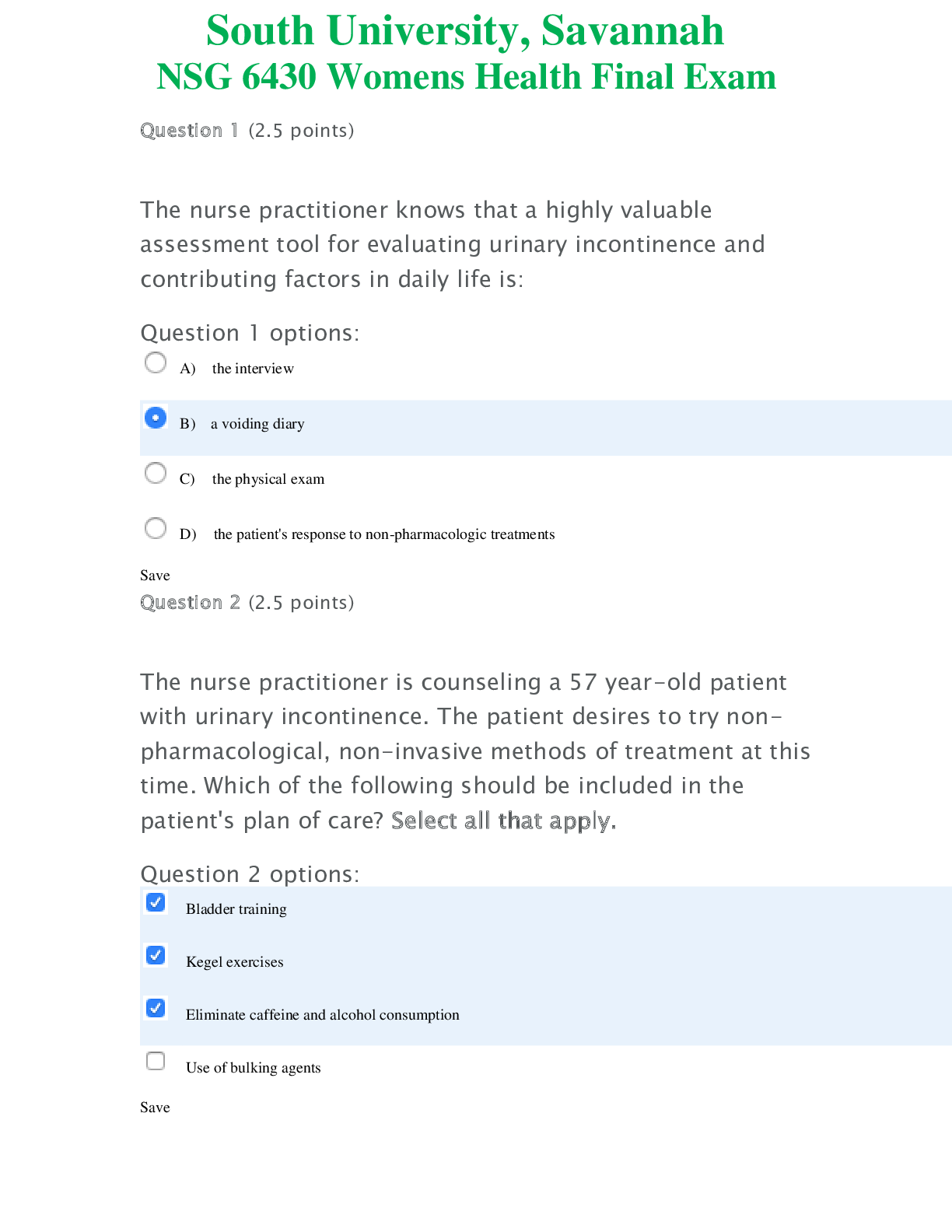
Reviews( 0 )
Document information
Connected school, study & course
About the document
Uploaded On
Apr 13, 2020
Number of pages
51
Written in
Additional information
This document has been written for:
Uploaded
Apr 13, 2020
Downloads
1
Views
92

